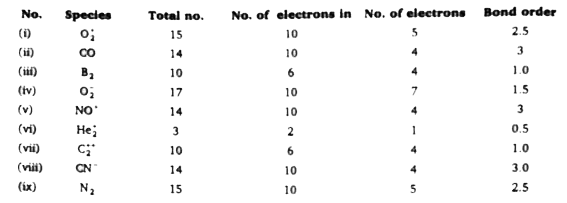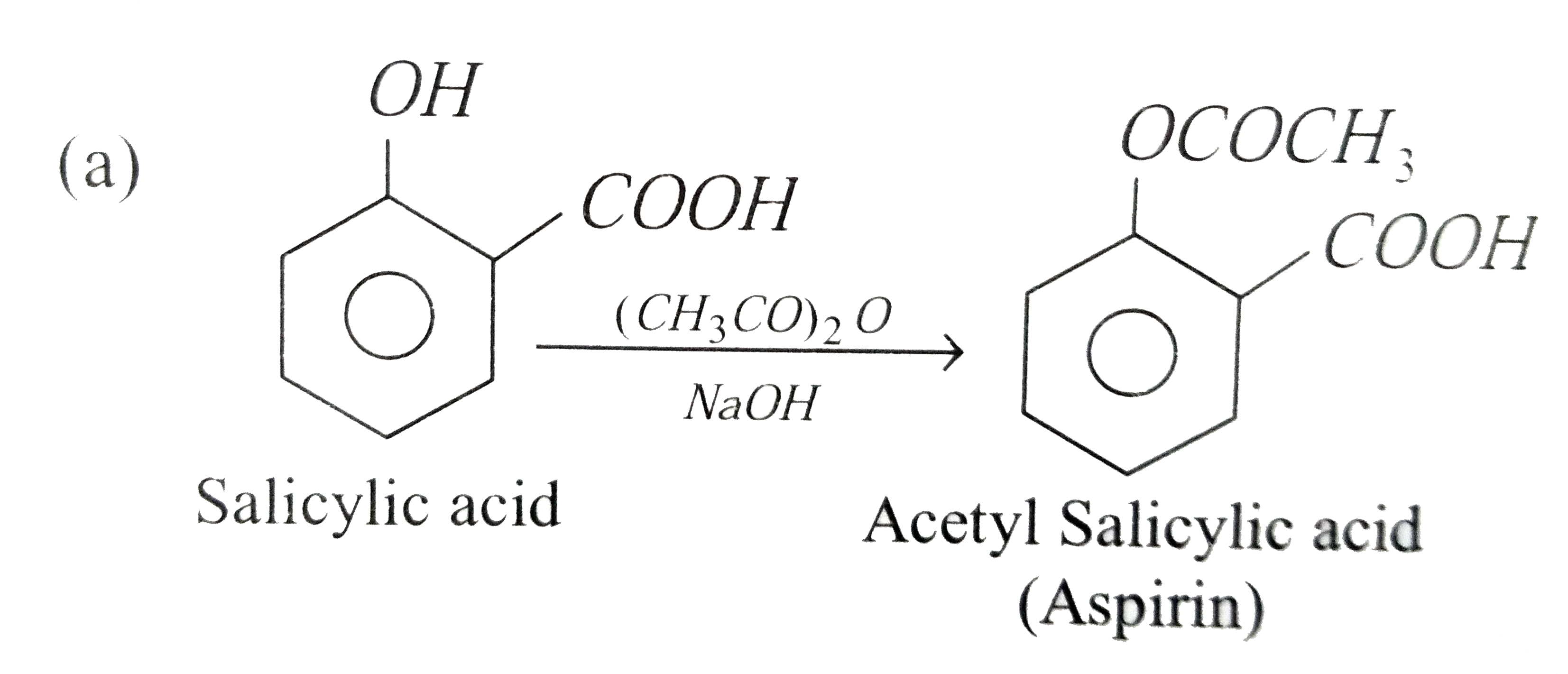InterviewSolution
This section includes InterviewSolutions, each offering curated multiple-choice questions to sharpen your knowledge and support exam preparation. Choose a topic below to get started.
| 11151. |
What is the molality of ethyl alcohol (molar mass = 46) in aqueous solution which freezes at -10^(@)C: K_(f)for water = 1.86 K "molality"^(-1) |
|
Answer» `3.540` `:.10 = 1.86 xx m ` or ` m=5.376` |
|
| 11153. |
Which of the following statements for the order of a reaction is incorrect? |
|
Answer» ORDER can be determined only experimentally. |
|
| 11155. |
Which of the following compounds will give red precipitate when heated with Fehling's solution? |
|
Answer» `R-OVERSET(OH)overset(|)CH-overset(O)overset(||)C-CH_(2)-R` |
|
| 11156. |
There are some species given below. (i)O_(2)^(+)(ii)CO(iii)B_(2)(iv)O_(2)^(-)(v)NO^(+)(vi)He_(2)^(+)(vii)C_(2)^(2+)(vii) CN^(-)(ix) N_(2)^(-) total number of species which have fractional bond order. |
|
Answer» `sigma_(1s)ltoverset("*")(sigma_(1s))ltsigma_(2S)ltoverset("*")(sigma_(2s))ltpi_(2px)pi_(2py)ltsigma_(2px)ltoverset("*")(pi_(2px))=overset("*")(pi_(2py))ltoverset("*")(simga_(2px))` For more than 14 electrons `sigma_(1s)ltoverset("*")(sigma_(1s))ltsigma_(2s)ltoverset("*")(sigma_(2s))ltpi_(2px)=pi_(2py))ltoverset("*")(pi_(2px))=overset("*")(pi_(2py))ltoverset("*")(pi_(2px))` BOND order `=(1)/(2)` numberof electron in [Bonding M.O.-Antibonding M.O.] 
|
|
| 11157. |
Which one of the following cannot be estimated by I_(2)? |
|
Answer» `SnCl_(2)` |
|
| 11158. |
Whichof the following statementis worong aboutphoton ? |
|
Answer» Photon's energy is HV |
|
| 11159. |
Which of the following metal hydroxide is the least basic ? |
|
Answer» `MG(OH)_(2)` |
|
| 11160. |
What is an electric resistance ? Give note on it. |
|
Answer» Solution :* The electrical resistance of any object is directly proportional to its length L and inversely proportional to its AREA of cross section A. That is, `R prop (l)/(A)` * `(R=rho((l)/(A)))` Where, `rho=`equilibrium constant The constant of proportionality. `rho` (Greek, rho) is called resistivity (specific resistance). * The electrical resistance is represented by the SYMBOL .R. and it is measured in ohm `(Omega)`. * Its SI base units is equal to ` (kg" " m^(2))/(S^(3)A^(2))`. It can be measured with the help of a Wheatstone BRIDGE. * Where, A=area and S=time 1 ohm `=1Omega=1(kg" "m^(2))//(S^(3)A^(2))` `1Omega" "m=100Omega" cm or "1Omega" cm"=0.01Omegam` |
|
| 11161. |
What are the characteristiics of the following : (i) Multimolecular colloids (ii) Lyophobocsols (iii)Emulsions. |
| Answer» | |
| 11162. |
Which solutions has the highest pH value |
|
Answer» 1M KOH |
|
| 11163. |
Which one of thefollowing is a condensation polymer ? |
|
Answer» Nylon |
|
| 11164. |
What is the difference in the nature of a dilute soap solution and a concentration soap solution ? |
| Answer» SOLUTION :DILUTE soap soluton behaves like a TURE solution WHEREAS concentrated soap solution behaves like a COLLOIDAL solution. | |
| 11165. |
Which of the following statements are not correct ? (I)Both Cr^(2+) and V^(2+) can liberate H_(2) from a dilute acid (II) Mn_(2) O_(7) is more acidic than MnO_(2) and Mn_(3) O_(4) (III) Oxidising power follows the sequence : VO_(2)^(+) gt Cr_(2) O_(7)^(2-) gt MnO_(4)^(-) (IV) Lu(OH)_(3) is more basic than La(OH)_(3) |
|
Answer» I , IV |
|
| 11166. |
The role of phosphate in detergent powder is to |
|
Answer» control pH LEVEL of the detergent WATER mixture |
|
| 11167. |
When a compound X reacts with ozone in aqueous medium, a compound Y is prouduced. Ozone also react with Y and produces Z. Z acts as an oxidising agent, then X,Y and Z will be: |
|
Answer» `X=HI,Y=I_(2) " and " Z=HIO_(3)` |
|
| 11168. |
Which of the following sugars is present in genetic factor DNA molecule : |
|
Answer» Glucose |
|
| 11169. |
Which of the following complex will show optical activity ? |
|
Answer» `trans-[Co(NH_(3))_(4)Cl_(2)]^(+)` |
|
| 11170. |
Zone refining is used for the |
|
Answer» CONCENTRATION of an ore |
|
| 11171. |
Which of the following statement regarding the metallurgy of magnesium using electolytic method is not correct ? |
|
Answer» ELECTROLYTE is magnesium chloride containing a littlr of NaCl and NaF |
|
| 11172. |
which of thefollowingis notthecharacteristic of ionicsolids? |
|
Answer» Very low value of electrical conductivity in the MOLTEN state |
|
| 11173. |
When salicylic acid is treated with acetic anhydride we get |
|
Answer» Aspirin 
|
|
| 11174. |
What do you understand by the 'order of a reaction' ? Identify reaction order from each of the given units of rate constant : (i)L^(-1)."mol".s^(-1)(ii)L^(-1)."mol".s^(-1) |
|
Answer» Solution : 2nd Part : (i) `"mol.L"^(-1).s^(-1)rarr` ZERO order reaction. (ii) `"L. mol"^(-1).s^(-1)rarr` SECOND order reaction. |
|
| 11175. |
Which one of the following statements about diborane is NOT true |
|
Answer» the B atoms in it are `sp^(3)` hybridised |
|
| 11176. |
Which of the following solvent will be able to dissolve dioxygen appreciable? |
| Answer» Answer :A | |
| 11177. |
When chlorine is passes through concentrated solution KOH, the compound formed is: |
|
Answer» `KClO_5` |
|
| 11178. |
Write Gibb's Helmholtz equation. For a process , if Delta H and T Delta S are positive and T Delta S gt Delta H, predict the spontaneity of the process. |
|
Answer» Solution :`Delta G= Delta H-T Delta S OR ` `Delta G^@=Delta H^@- T Delta S^@` The PROCESS is SPONTANEOUS. |
|
| 11179. |
Which of the following complexes is an outer orbital complex? |
|
Answer» `[Fe(CN)_6]^(4-)` |
|
| 11180. |
water is brought to boil under a pressure of 1.0 atm. When an electric current of 0.50 A from 12 V supply is passed for 300 s through a resistance in thermal contact with it , it found that 0.798 g of water is vaporised . Calculate the molar internal energy change at boiling point (375 .15 K). |
|
Answer» ` 37 .5 kJ mol ^(-1)` `1800 J =+1.8 kJ` molar enthaply of vaporisation, `DeltaH_(m)=(DeltaH)/(moles of H_(2)O)=(DeltaH)/n_(H_(2)^(O))=(1.8kJ)/(0.798/18)=40.6 kJ mol^(-1)` `DeltaH_(m)=DeltaE_(m)+P DeltaV` `DeltaH_(m)=DeltaE_(m)+Deltan_(g)RT` `DeltaH_(m)=DeltaE_(m)+RT` molar internal energy change , `DeltaE_(m)=DeltaH_(m)-RT` `=40.6-8.314xx10^(-3)xx373.15=37.5 kJ mol^(-1)` |
|
| 11181. |
Tthethermaldecompostionof alkanesis known as : |
|
Answer» cracking |
|
| 11182. |
Which of the following statement is not true about Mohr's salt |
|
Answer» It decolourises `KMnO_(4)` `FeSO_(4)(NH_(4))_(2)SO_(4).6H_(2)O" is "+2.` |
|
| 11183. |
Which of the following compound undergo nucleophilic substitution faster? |
|
Answer»
|
|
| 11184. |
Which of the following synthesis gives 3-methyl -1- hexanol ? |
|
Answer» 2- Bromohexance ` overset("Mg") underset("dry ETHER")tooverset("(i) HCHO") underset("(ii)" H_(3)O^(+)) to ` |
|
| 11185. |
The reduction of aldehydes and ketones to the corresponding alkanes in presence of alkaline hydrazine solution is called: |
|
Answer» MPV reaction |
|
| 11186. |
The standard reduction potential of E_(Bi^(3+)//Bi)^(@) and E_(Cu^(2+)//Cu)^(@) are 0.226 V and 0.344 V respectively. A mixture of salts of Bi and Cu unit concentration each is electrolysed at 25^(@)C. To what value can [Cu^(2+)] be brought down before bismuth starts to deposit during electrolysis ? |
|
Answer» |
|
| 11187. |
What would be energy order of d-orbitals of tetrahedral complexes when they undergo splitting ? |
|
Answer» `d_(XY) ~= d_(y_2) ~= d_(xz) lt d_(x^2-y^2)~= d_z^2` |
|
| 11188. |
Which does not react with Fehling solution ? |
|
Answer» Ethanal Hence , they REDUCE Fehling solution. |
|
| 11189. |
Which will undergo Fredel-Crafts alkylation reaction easily ? |
|
Answer» |
|
| 11191. |
What is the SI unitof denisty? |
|
Answer» G `CM^(-3)` |
|
| 11192. |
There are 20 naturally occuring amino acids. The maximum number of tripeptides that can be obtained is |
|
Answer» 6470 `:.` MAXIMUM no. of ripeptides that can be obtainees are `=(20)^(3)=8000`. |
|
| 11193. |
Which pair of electrolytes could not be distinguished by the products of electrolysis using inert electrodes? |
|
Answer» 1 M `CuSO_(4)` solution, 1 M `CuCl_(2)` solution (b) `KCl toH_(2)+Cl_(2),KItoH_(2)+I_(2)` (C) `AgNO_(3)toAg+O_(2),Cu(NO_(3))_(2)toCu+O_(2)` (d) `KCl to H_(2)+Cl_(2),NaCl toH_(2)+Cl_(2)` (E) `CuBrtoCu+Br_(2),CuSO_(4)toCu+O_(2)` Thus, KCl and NaCl solutions give the same products at anode and cathode. |
|
| 11194. |
The thermal decomposition of acetaldehyde , CH_(3)CHO to CH_(4)+CO, has rate constant of 1.8xx10^(-3)"mole"^(-1//2)L^(1//2)min^(-1) at a given temperature. How would (d[CH_(3)CHO])/(dt) will change if concentration of acetaldehyde isdoubled keeping the temperature constant ? |
|
Answer» Will INCREASE by `2.828` times |
|
| 11195. |
X gives white turbidity with Lucas reagent instantly. X and Y both turn blue litmus solution red. Y can be: |
|
Answer» <P>p- HYDROXY BENZOIC acid |
|
| 11196. |
underset((X))(C_(4)H_(8)O_(4))overset(LiAlH_(4))rarroverset(HBr)rarroverset(NaCN)rarroverset(H_(3)overset(oplus)O,CaO)underset(Delta)rarrYoverset(CaO, Delta)larr hexanedioic acid : |
|
Answer»
|
|
| 11197. |
Which of the following two substances react to form Blister copper? |
|
Answer» `Cu_2 + FeS_2` |
|
| 11198. |
Van der Waal's equation for n moles of a gas is |
|
Answer» `(P+(N^(2)a)/(V^(2)))(V-nb)=nRT` `(P+(n^(2)a)/(V^(2)))(V-nb)=nRT` |
|
| 11199. |
Which reference electrode is used to measure the electrode potential of other electrodes ? |
|
Answer» SOLUTION :* Standard Hydrogen electrode * Reduction potential of standard hydrdogen electrode is ACCEPTED to be ZERO volt. And so it is considered to be REFERENCE electrode to measure the electrode potential of any electrode. |
|
| 11200. |
Which of the following is not true for ozone ? |
|
Answer» It is a strong sterilizing agent  a) `O_3` is also used as disinfectant. Its advantage over chlorine for purifying drinking water is that it avoids the unpleasant smell and bad taste of chlorine. b) Reaction of alkene with `O_3`, followed by TREATMENT with Zn in presence of water to FORM carbonyl compounds is CALLED ozonolysis. `ge C=C le underset(2. Zn//H_(2)O)overset(1. O_(3))to ge C=O+O=C le` (d) After `F_2, O_3` is most powerful oxidant, e.g., `PbS+4O_(3) to PbSO_(4)+2O_(2)` |
|